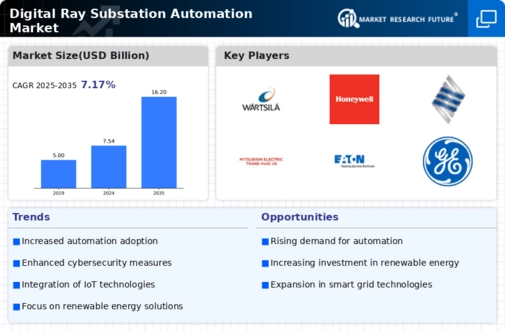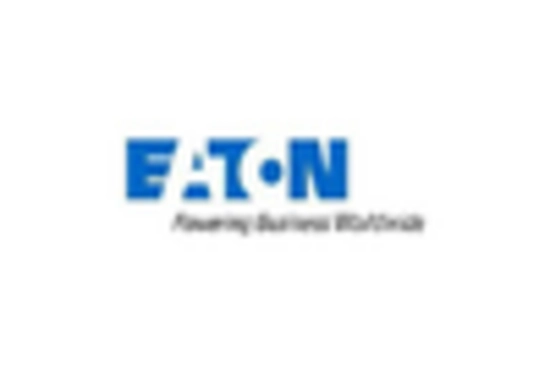Government Initiatives and Regulations
Government policies and regulations aimed at enhancing energy efficiency and reliability are significantly influencing the Digital Ray Substation Automation Market. Various countries have implemented stringent regulations that mandate the modernization of electrical infrastructure, which includes the adoption of digital substation technologies. For instance, initiatives promoting smart grid technologies are expected to drive investments in automation solutions. The market is projected to grow at a compound annual growth rate (CAGR) of 8% from 2025 to 2030, largely due to these regulatory frameworks. As governments continue to prioritize energy security and sustainability, the Digital Ray Substation Automation Market is poised to experience robust growth, driven by compliance with these evolving standards.
Rising Demand for Renewable Energy Sources
The increasing emphasis on renewable energy sources is a pivotal driver for the Digital Ray Substation Automation Market. As nations strive to meet sustainability goals, the integration of renewable energy into existing grids necessitates advanced automation solutions. This shift is projected to enhance grid reliability and efficiency, with the market for substation automation expected to reach USD 30 billion by 2026. The Digital Ray Substation Automation Market is likely to benefit from this trend, as utilities seek to modernize infrastructure to accommodate fluctuating energy inputs from solar and wind sources. Consequently, the demand for sophisticated automation technologies that can manage these complexities is anticipated to surge, thereby propelling market growth.
Increased Investment in Smart Grid Technologies
The surge in investments directed towards smart grid technologies is a significant driver for the Digital Ray Substation Automation Market. Utilities are increasingly recognizing the value of smart grids in enhancing operational efficiency and customer engagement. The integration of digital technologies into substations facilitates better energy management and distribution, which is essential for meeting modern energy demands. The market is projected to grow substantially, with estimates suggesting a valuation of USD 28 billion by 2027. This trend indicates a strong commitment from stakeholders to modernize energy systems, thereby fostering growth within the Digital Ray Substation Automation Market as utilities adopt innovative solutions to improve service delivery.
Growing Focus on Grid Resilience and Reliability
The imperative for enhanced grid resilience and reliability is driving the Digital Ray Substation Automation Market. As energy demands escalate, the need for robust infrastructure that can withstand disruptions becomes paramount. Automation technologies play a vital role in ensuring that substations can quickly respond to outages and maintain service continuity. The market is likely to see an increase in investments aimed at fortifying grid infrastructure, with projections indicating a market growth rate of 7% annually through 2030. This focus on resilience is expected to catalyze the adoption of digital solutions within the Digital Ray Substation Automation Market, as utilities seek to mitigate risks associated with aging infrastructure and climate-related challenges.
Technological Advancements in Automation Solutions
Technological innovations are a crucial driver for the Digital Ray Substation Automation Market. The advent of advanced automation technologies, such as artificial intelligence and machine learning, is transforming the operational landscape of substations. These technologies enable predictive maintenance, real-time monitoring, and enhanced decision-making capabilities. The market is witnessing a shift towards more intelligent systems that can analyze vast amounts of data to optimize performance. As a result, the Digital Ray Substation Automation Market is expected to expand, with a projected market size of USD 25 billion by 2025. This growth is indicative of the increasing reliance on cutting-edge technologies to improve operational efficiency and reduce downtime.

















Leave a Comment